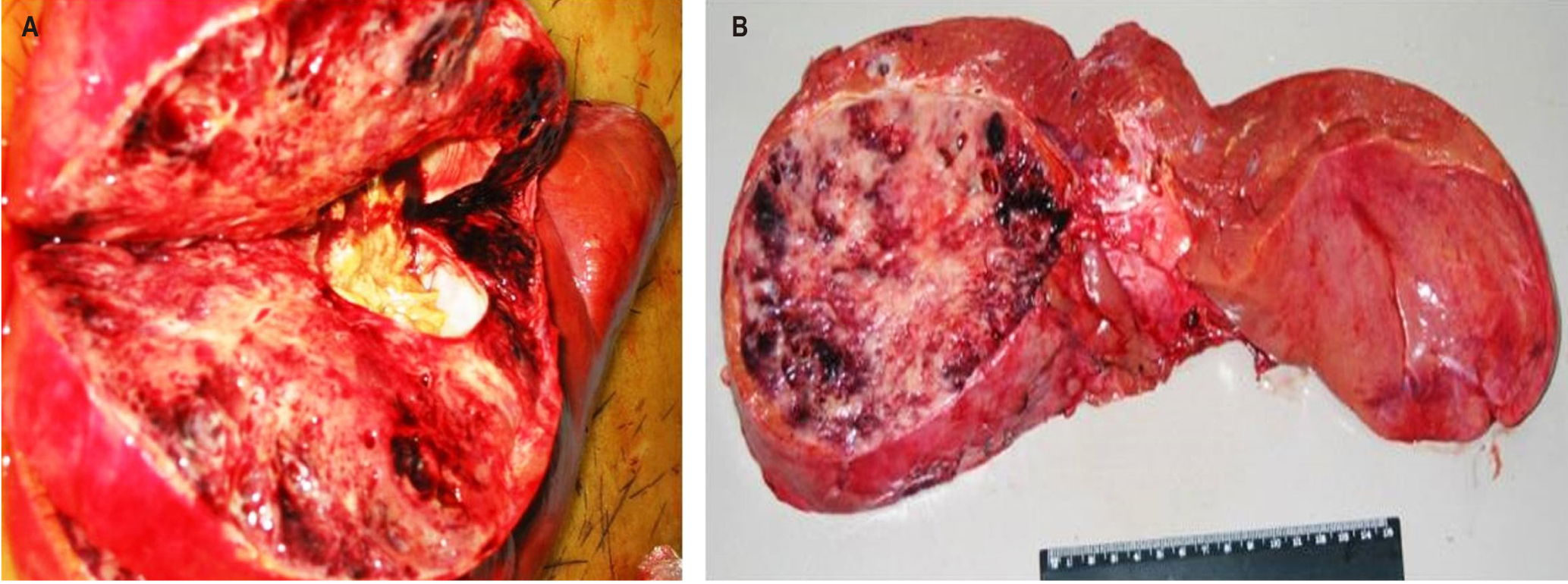Adult hepatoblastoma
a case report
DOI:
https://doi.org/10.22516/25007440.339Keywords:
Liver tumors, hepatoblastoma, liver cancer, adultsAbstract
Background: In contrast to childhood hepatoblastoma, adult hepatoblastoma (HBA) is a rare and not-fully-understood liver tumor with a poor prognosis. To date, about 50 cases have been adequately reported in the medical literature.
Objective: We present the case of a patient who was discharged from our hospital with a diagnosis of hepatocellular carcinoma approximately 3 months before returning.
Clinical case: A 60-year-old male patient with a history of alcoholism and heavy smoking was admitted to our hospital for abdominal pain. Physical examination revealed a palpable tumor in the right hypochondrium region. This patient had been discharged approximately 3 months previously with a diagnosis of hepatocellular carcinoma in the course of liver cirrhosis. The patient died, and the autopsy revealed an HBA.
Conclusions: Adult hepatoblastoma is an infrequent tumor with a severe prognosis. Many cases are asymptomatic until the time of diagnosis, and the tumor is usually very large. Liver enzymes, alpha-fetus protein, and imaging studies lead to a diagnosis of hepatocellular carcinoma which is a common tumor in adults. Histological study confirms the diagnosis. Due to the poor prognosis for HBA in contrast to better prospects for treatment of hepatoblastoma in children, it is logical to use pediatric treatment in adults. More research is needed for the optimal treatment of HBA.
Downloads
References
Rougemont AL, McLin VA, Toso C, Wildhaber BE. Adult hepatoblastoma: learning from children. J Hepatol. 2012;56(6):1392‐1403.
http://doi.org/10.1016/j.jhep.2011.10.028
de Bree K, Westermann AM, Klümpen HJ, Verheij J, Phoa SS, Oomen M, van Gulik TM. Two Cases of Hepatoblastoma in Young Adults. J Adolesc Young Adult Oncol. 2018;7(3):404‐408.
http:// doi.org/10.1089/jayao.2017.0125
Duan XF, Zhao Q. Adult hepatoblastoma: a review of 47 cases. ANZ J Surg. 2018;88(1-2):E50‐E54.
http//doi.org/10.1111/ans.13839
von Schweinitz D. Hepatoblastoma: recent developments in research and treatment. Semin Pediatr Surg. 2012;21(1):21‐30.
http://doi.org/10.1053/j.sempedsurg.2011.10.011
Darwiche H, Petersen BE. Biology of the adult hepatic progenitor cell: “ghosts in the machine”. Prog Mol Biol Transl Sci. 2010;97:229‐249.
http://doi.org/10.1016/B978-0-12-385233-5.00008-8
Cotran RS, Kumar V, Collins J. Hígado y vías biliares. En. Cotran RS, Kumar V, Collins J. Patología Estructural y Funcional de Robbins. Madrid: McGraw-Hill Interamericana; 2006. p. 926.
Wang YX, Liu H. Adult hepatoblastoma: systemic review of the English literature. Dig Surg. 2012;29(4):323‐330. http://doi.org/10.1159/000342910
Litten JB, Tomlinson GE. Liver tumors in children. Oncologist. 2008;13(7):812‐820.
http://doi.org/10.1634/theoncologist.2008-0011
Barnett WH, Erickson EE, Halpert B. Embryonic tumor of the liver in an adult. Cancer. 1958;11(2):306‐309.
http://doi.org/10.1002/1097-0142(195803/04)11:2<306::aid-cncr2820110211>3.0.co;2-r
Zimmerman A, Saxena R. Hepatoblastoma. En: Bosman F, Carneiro F, Hurban R, Theise. WHO Classification of Tumours of the Digestive System. Lyon: International Agency for Research on Cancer; 2010. p. 228-35.
Cairo S, Armengol C, Buendia MA. Activation of Wnt and Myc signaling in hepatoblastoma. Front Biosci (Elite Ed). 2012;4:480‐486.
Diehl AM. Neighborhood watch orchestrates liver regeneration. Nat Med. 2012;18(4):497‐499.
http://doi.org/10.1038/nm.2719
Boulter L, Govaere O, Bird TG, Radulescu S, Ramachandran P, Pellicoro A, Ridgway RA, Seo SS, Spee B, Rooijen NV, Sansom OJ, Iredale JP, Lowell S, Roskams T, Forbes SJ. Macrophage-derived Wnt opposes Notch signaling to specify hepatic progenitor cell fate in chronic liver disease. Nat Med. 2012;18(4):572‐579.
http://doi.org/10.1038/nm.2667
Caso-Maestro Ó, Justo-Alonso I, Cambra-Molero F, Manrique-Municio A, Calvo-Pulido J, Jiménez-Romero C. Adult hepatoblastoma: case report with adrenal recurrence. Rev Esp Enferm Dig. 2013;105(10):638‐639.
http:/doi.org/10.4321/s1130-01082013001000014

Downloads
Published
How to Cite
Issue
Section
License
Aquellos autores/as que tengan publicaciones con esta revista, aceptan los términos siguientes:
Los autores/as ceden sus derechos de autor y garantizarán a la revista el derecho de primera publicación de su obra, el cuál estará simultáneamente sujeto a la Licencia de reconocimiento de Creative Commons que permite a terceros compartir la obra siempre que se indique su autor y su primera publicación en esta revista.
Los contenidos están protegidos bajo una licencia de Creative Commons Reconocimiento-NoComercial-SinObraDerivada 4.0 Internacional.

| Article metrics | |
|---|---|
| Abstract views | |
| Galley vies | |
| PDF Views | |
| HTML views | |
| Other views | |
















